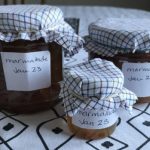Lesley Johnston’s Orange Marmalade
 Tom Cooks! is continuing the theme of things to spread on your toast. That's about the only thing that today's recipe has in common with last week's lemon curd. That one was quick. This week's, like January itself, seems to go on for ever. Seville oranges will only be available for another couple of weeks or thereabouts, so act soon.
Tom Cooks! is continuing the theme of things to spread on your toast. That's about the only thing that today's recipe has in common with last week's lemon curd. That one was quick. This week's, like January itself, seems to go on for ever. Seville oranges will only be available for another couple of weeks or thereabouts, so act soon.
Lesley eases the load by employing two labour saving devices. The first of these is a juicer attachment which fits on top of the Magimix. The second is a husband. The latter is handy for chopping up the peel and helping with the stirring. Don't worry if you don't have a traditional pot, or jeelie pan as we call it in Scotland. A good large thick bottomed one will do.

Lesley Johnston
Some recipes call for special preserving sugar, which contains added pectin. The reason that marmalade is traditionally made at this time of year is because of the availability of bitter Seville oranges. Unpleasant to eat, but the bitterness makes for a terrific finished product. The addition of a couple of lemons gives an extra dimension. The pith and pips of the Seville variety are rich in pectin, which is why the latter must be collected and securely wrapped in a muslin bag. (If you don't have muslin you could use a clean J cloth.) Note the word securely. You do NOT want the job of going fishing for pips in a large vat of hot liquid. Use granulated sugar, not caster. The larger crystals dissolve more slowly.
Experienced jam makers can ignore the next three paragraphs, but one or two important points for first timers. Marmalade is a preserve, i.e. is intended to be capable of being stored for a good while. You therefore need to sterilise the jars before using. To do this, preheat your oven to 140°C/Mark 1. Wash the jars and lids in hot soapy water, rinse and put on an oven tray. Place the tray in the oven for at least 20 minutes.
When you come to fill the jars, make sure they're warm, and leave them on the tray to catch drips. Pour hot jam into cold jars and they may crack. Some books will suggest you use Kilner jars because of their seal. Expensive and not necessary provided the lid has a good seal and the jars are well filled.
Ah, filling. How are you going to do this? From a very large pan, you might think a ladle to be the obvious tool. Yes and no. Use your ladle to fill a jug, and pour from jug to jars. Let the mixture cool for 10 minutes or so before doing this and please, please, please, be very careful. The burns you can get from a boiling combination of fruit and sugar don't bear thinking about.
If you're left with an awkward half filled jar, eat that first. It's useful to have jars of varying sizes for just that eventuality. They also make excellent gifts.
Ingredients
1 kilo Seville oranges; 2 lemons; 2.8 litres water; 1.5kg granulated sugar.
************************************************
Wash the fruit. Cut in half then squeeze the juice into a bowl which will be large enough to hold the juice, the water and all the peel. Get your willing helper/spouse if you have one, and get slicing. The size of your slices will depend on personal taste, and also on the skill of the slicer. We prefer ours quite chunky, though ca' canny. I recently opened a jar of lime marmalade from last year, and the size of the rind meant you needed your own teeth.
Gather the pips and wrap them tightly in muslin. Put the peel and pips into the juice bowl with the water, cover and leave for 24 hours.
Transfer to your pan and simmer, stirring from time to time, until the orange peel is tender. Some recipes say this takes two hours: Lesley who has a low attention span, thinks she gave it about one. Then add the sugar, and allow it to dissolve. When melting sugar, it has to be allowed to dissolve gently, otherwise something happens to the crystal structure. I don't know what.
Once the sugar is melted bring to a boil then simmer, stirring all the while. One recipe I've seen says to boil rapidly until setting point is reached - about 20 minutes apparently. Lesley's method is different. Simmer until it reaches setting point, she says. Go to the loo first, she advises, because it'll take more time than you think. How long? I enquire gently. For flipping ever, comes the reply. You can easily allow an hour. As one who has shared the joy of the stirring, I can concur.
How do you know when setting point has been reached? The scientists will use a thermometer. I have read both 104.5˚ and 106˚C as being the optimum temperature. Traditionalists will use the wrinkle test. Pour a little of the mixture on to a cold plate and tilt it. The mixture should flow down very slowly. If you run your finger through it it should wrinkle, hence the name.
Pour into jars when ready and leave for a day to cool. Label. If they are your first born jars, remember to autograph and date them, then boast about it for months on social media.
Love the photo.
One tip my sister gave me is to freeze the oranges first. When defrosted they are much easier to chop or liquidise.
The other useful thing is the Lakeland Jam Funnel which fits over all sizes of jars and makes pouring the hot marmalade much easier.
Just a point about filling the jars. You can also buy a metal funnel for this purpose but not essential. I use a metal s/s jug as a glass one if not Pyrex might crack or worse break.
I also put the hot sterilised glass jars on a cooling rack over a tray to prevent mess Nice post Tom 👍👏👏👏✅